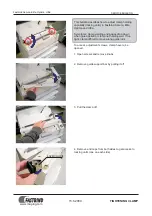
22
1540
1530
1520
Utility stitches and practical sewing
Explanation of the sewing chart
The following charts show the recommended
settings for each stitch or technique.
These charts also provide you with further
instructions that are necessary when sewing
the selected stitches.
The choice of the sewing foot, the setting
of the needle thread tension and whether
the sewing is carried out with the top feed
switched on or off.
Always use the “center” needle position
if not otherwise specifi ced in the
instructions.
stitch
stitch
Stitch number
Stitch width in mm
Stitch length in mm
Dual feed
on =
off
=
Thread tension
Presser foot number
Summary of Contents for select 1520
Page 1: ...select 1520 1530 1540 Instruction manual ...
Page 2: ...1 2 3 4 5 6 7 8 9 10 11 12 13 14 15 16 18 17 19 20 21 22 23 24 25 26 27 28 29 ...
Page 4: ......
Page 30: ...20 Operate your Pfaff select ...
Page 76: ...66 Accessories and needles ...
Page 81: ......
















































